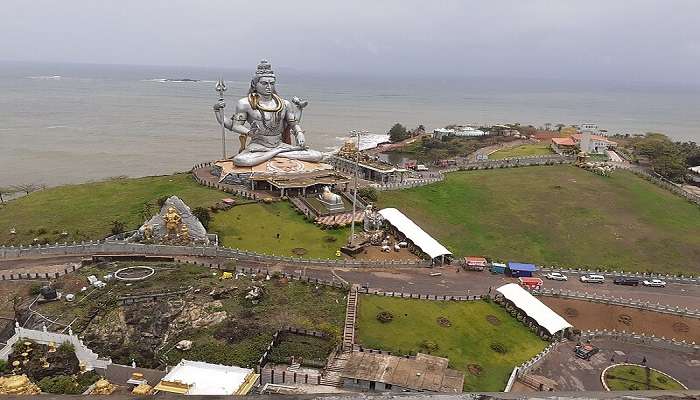Explore Preah Khan Temple Of Ancient Angkor In 2026
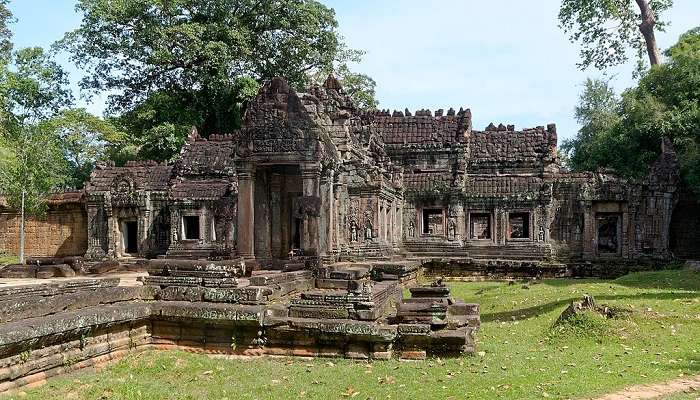
Nestled deep within the ancient Khmer empire’s former capital of Angkor in present-day Cambodia, Preah Khan Temple is one of the most remarkable and enigmatic religious monuments from the Angkorian era. Built-in the late 12th century during the reign of Jayavarman VII, this sprawling monastic complex was originally dedicated to Buddhism before becoming a Hindu temple complex. Its partially collapsed corridors, overgrown galleries, and crumbling sanctuaries consumed by the voracious embrace of towering silk cotton and strangler fig trees have also made it one of Angkor’s most atmospheric and alluring ruins. Explore Preah Khan’s mystical ruins today with this article.
About Preah Khan Temple
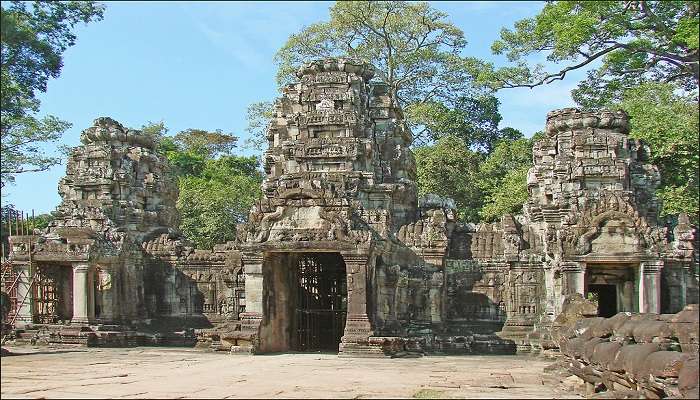
The Preah Khan Temple, standing tall in Cambodia’s Angkor Archaeological Park, is a magnificent monument boasting a rich history and architectural grandeur. Built in the 12th century by King Jayavarman VII, the temple served multiple purposes—honouring his father, functioning as a city, and being a Buddhist university.
Encompassing a vast area of over 56 hectares, Preah Khan is enclosed within a rectangular moat and fortified walls. Eagle-eyed visitors can spot carvings of garudas, divine eagle-like beings, adorning these walls. The complex is a labyrinth of vaulted corridors leading to various fascinating structures. Towering enclosures, courtyards, shrines, and halls characterise the temple’s layout. One particularly captivating feature is the Hall of Dancers, hinting at the vibrant activities that once took place within the complex.
Unlike its more overgrown counterpart, Ta Prohm, Preah Khan is moderately preserved. Restoration efforts by the World Monuments Fund (WMF) are ongoing, ensuring this architectural gem continues to stand the test of time. Detailed carved figures and lichen-covered stonework add to the temple’s charm, offering a glimpse into the artistic mastery of the Khmer Empire.
Must Read: Resorts In Sihanoukville
History Of Preah Khan Temple
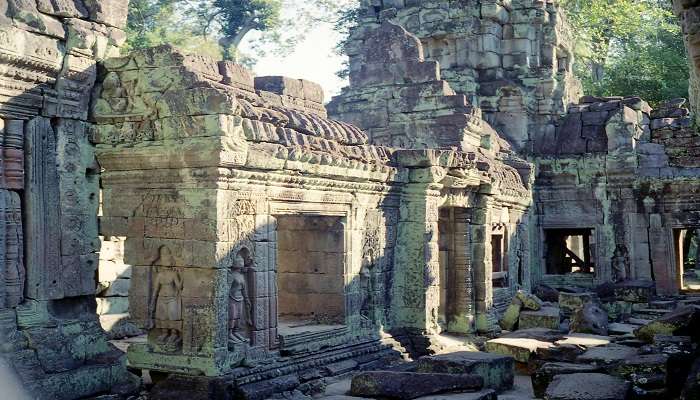
Built-in the late 12th century Jayavarman VII, the temple’s name, translates into “Royal Sword” or “Holy Sword,” reflects its origins as “Nagara Jayasri” or “the holy city of victory.” This name commemorates Jayavarman VII’s triumphant defeat of the Cham armies in 1191 AD on the temple’s very site.
Preah Khan was not merely symbolic. Dedicated to Jayavarman VII’s father, it served multiple roles, functioning as a grand Buddhist monastery and educational center that housed over 1,00 centres. It also temporarily housed Jayavarman VII himself while Angkor Thom, his grand capital city, was being built. This dual function as a religious and royal center underscored Preah Khacentregnificance within the Khmer Empire.
Today, Preah Khan stands as a potent symbol of Cambodia’s heritage, showcasing the architectural skill of its era and offering a captivating glimpse into the Khmer Empire.
Architecture Of Preah Khan Temple
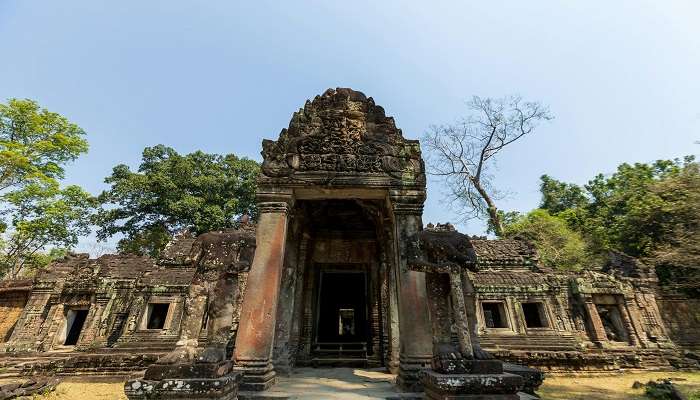
As with many temples, Preah Khan is oriented towards the east, making this the main entrance. However, there are additional entrances at each cardinal point. Between the southern two towers stood two renowned silk-cotton trees. Glaize described these trees as “resting on the vault itself of the gallery, framing its openings and bracing the stones like pillars in a fantastic and perilous caprice of nature.” One tree has since died, but its roots remain. The trees may need removal to prevent structural damage.
A courtyard with two libraries connects the Hall of Dancers to the second enclosure wall. The second eastern gopura, projecting into this courtyard, is one of the few Angkorian gopuras with significant internal decoration, featuring garudas on the cornices’ corners. Under Jayavarman VIII, Buddha images on the columns were altered to depict hermits. The walls of this gallery and the interior of the central sanctuary are marked with holes for attaching bronze plates, which initially covered them and the sanctuary’s exterior, using 1500 tonnes of bronze in total. At the temple’s centre, a stupa now replaces the original statue of Lokesvara, built several centuries after the initial construction.
Suggested Read: Angkor Archaeological Park
Preah Khan Temple Timings, Fees, And Best Time To Visit
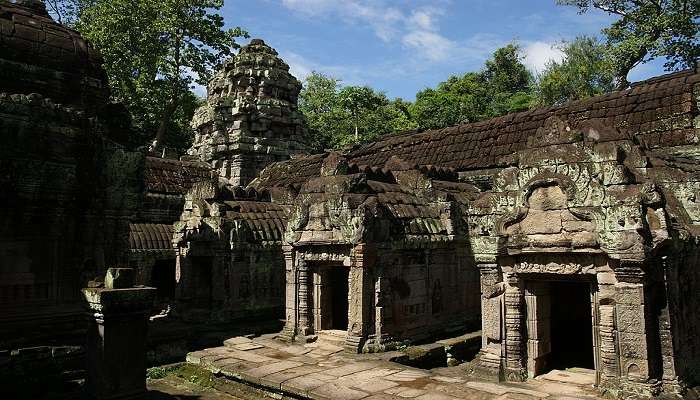
Preah Khan Temple follows the opening and closing hours of the entire Angkor complex. The temple is open to visitors daily from 5:00 AM to 6:00 PM.
There’s no separate entry fee for Preah Khan Temple itself. Entry is covered by the Angkor Pass, which grants access to the entire complex, including Angkor Wat, Bayon, Ta Prohm, and other temples. The Angkor Pass comes in three tiers:
- One-day pass: Valid for a single day, priced at $37
- Three-day pass: Valid for three consecutive days within one week, priced at $62
- Seven-day pass: Valid for seven consecutive days within a one-month period, priced at $72
You can purchase your Angkor Pass online or at the ticketing booths located near the main entrance of Angkor Wat.
How To Reach Preah Khan Temple

There are no direct ways to reach Preah Khan Temple, as it is part of the Angkor Archaeological Park. However, you can get to the Angkor Wat complex, the main entry point for the park, and from there, you can travel to Preah Khan Temple. Here are your options:
By Air
The nearest international airport is Siem Reap International Airport (REP). You can take a taxi, tuk-tuk, or ride-sharing service from the airport to Angkor Wat. The journey takes about 15-20 minutes, depending on traffic conditions.
By Road
Preah Khan Temple is located near Angkor Wat and other temples in the Angkor Archaeological Park. If you are already in Siem Reap, you can take a tuk-tuk or taxi or rent a bicycle or motorbike to reach the temple complex.
By Rail
There isn’t a train that goes directly to Preah Khan Temple. The closest train station is in Phnom Penh. You can travel to Angkor Wat by bus, taxi, or van from there. You can then hire a tuk-tuk to reach Preah Khan Temple.
Further Read: Prasat Ta Keo
Preah Khan Temple showcases the Khmer civilisation’s impressive architecture. It’s a captivating destination for exploring Cambodia’s cultural heritage. If you’re drawn to ancient wonders and want to experience Cambodia’s spiritual essence, now is the ideal moment to plan your trip. Book your trip to Cambodia today and let the mystical allure of Preah Khan Temple leave a lasting impression on you.
For our editorial codes of conduct and copyright disclaimer, please click here.
Cover Image Credit: Jakub Hałun for wikimedia commons
Frequently Asked Questions About Preah Khan Temple
What are the special features of Preah Khan?
Preah Khan, known as the ‘Royal Sword’, is a unique temple in Angkor, Cambodia. It was constructed in the 12th century by King Jayavarman VII as a tribute to his father. The vast complex encompasses entryways, towers, ceremonial spaces, courtyards, shrines, and many connecting corridors. Notable features include a two-story pavilion, a sanctum sanctorum once plated in bronze, and a Hall of Dancers.
Who built Preah Khan Temple?
The Preah Khan Temple was erected in the 12th century by King Jayavarman VII as a tribute to his father.
How old is Preah Vihear Temple?
The site of the Preah Vihear Temple dates back to the ninth century AD. Still, the majority of the temple as it stands today was built in the eleventh century.
What is the history of Prasat Preah Khan?
Preah Khan was constructed on the site of King Jayavarman VII's victory over the invading Chams in 1191. Its modern name, 'holy sword', is a translation of the original name—Nagara Jayasri (holy city of victory). The temple's foundation, stela, has provided a wealth of information about the site's history and administration. However, Preah Khan gradually declined after the Khmer royalty ceased its support around the 15th century.
What is the sword of Preah Khan reach?
The Khmer Royal Sacred Sword, known as Preah Khan Reach, is a straight, double-edged sword with a chiselled steel blade encased in a gold sheath adorned with jewels. Although it has been missing since 1970, it was considered a symbol of Khmer sovereignty and legitimacy to the throne for whoever possessed it.
People Also Read:
Wat Intharawihan Pura Taman Kemuda Saraswati Chamundeshwari Temple
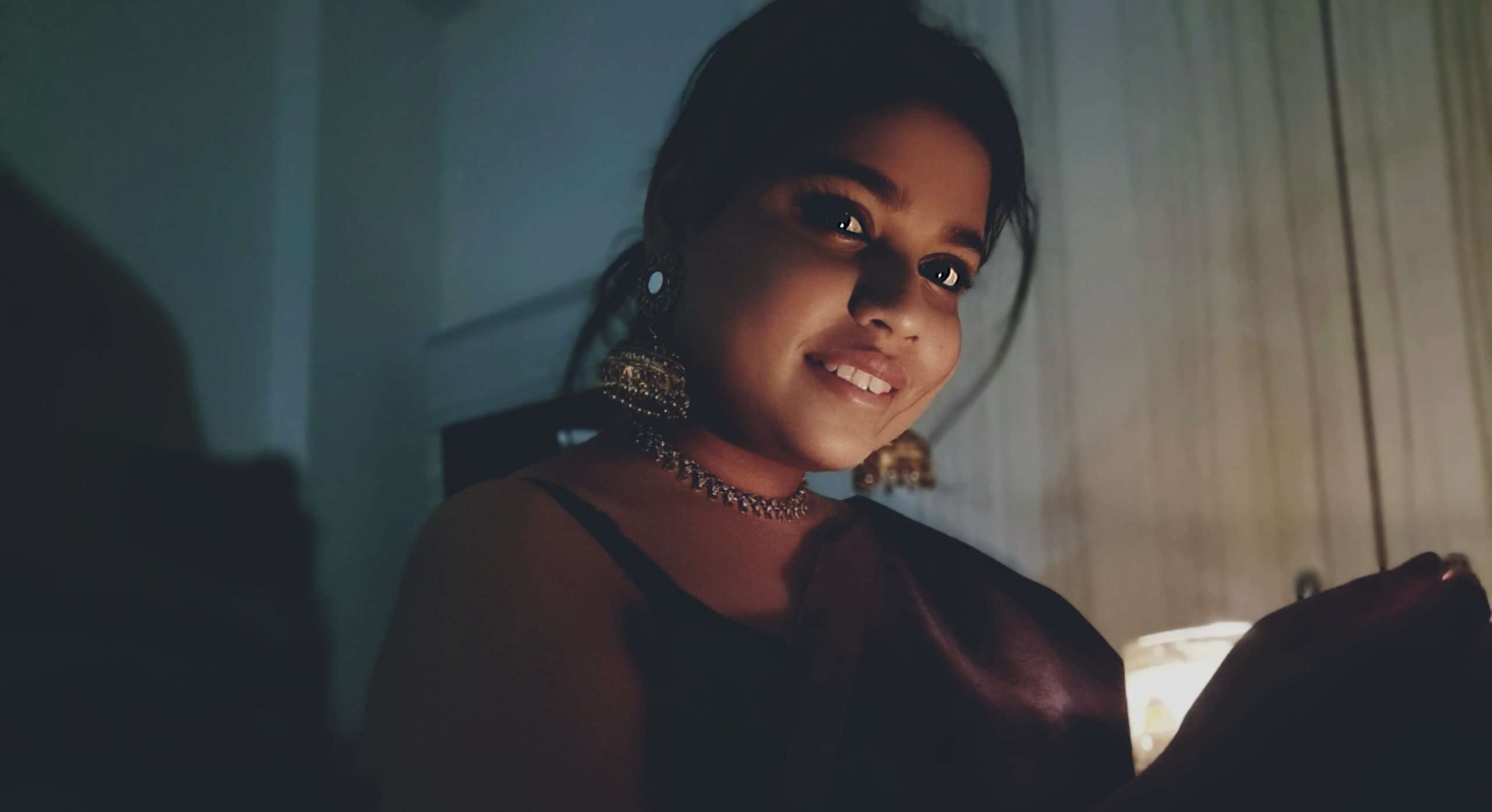
As a Travel Content Writer, I live to conquer the world of globetrotting with words. With my unquenchable thirst for storytelling, I believe that my words will inspire you to travel around the world’s breathtaking landscapes. As for me, I am an unapologetic selenophile, who loves to wander around in a starry night!




